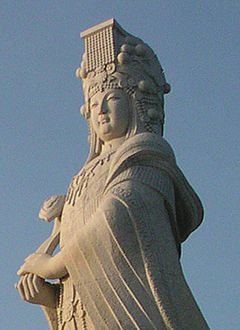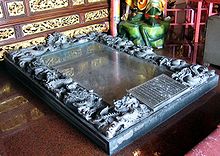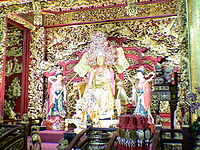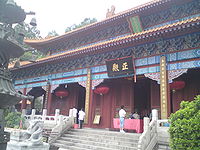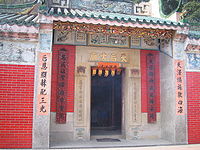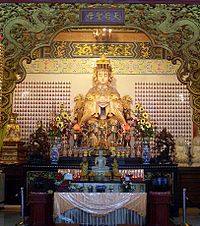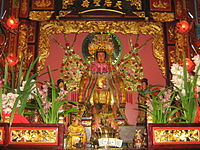- Mazu (goddess)
-
- Tin Hau redirects here. For other meanings of Tin Hau, see Tin Hau (disambiguation)
Mazu (simplified Chinese: 妈祖; traditional Chinese: 媽祖; pinyin: Māzǔ; Wade–Giles: Ma-tsu; Pe̍h-ōe-jī: Má-chó͘, Vietnamese: Ma Tổ; Foochow Romanized: Mā-cū; literally "Mother Ancestor"), also spelt Matsu, is the indigenous goddess of the sea who is said to protect fishermen and sailors, and is invoked as the patron deity of all Southern Chinese and East Asian persons. Born as Lin Moniang (Chinese: 林默娘; pinyin: Lín Mòniáng; Pe̍h-ōe-jī: Lîm Be̍k-niû; Foochow Romanized: Lìng Mĕk-niòng) in Fujian around 960 CE, worship of Mazu began around the Ming Dynasty, when many temples dedicated to her were erected all across Mainland China, later spreading to other countries with Southern Chinese inhabitants.
Mazu is widely worshipped in the south-eastern coastal areas of China and neighbouring areas in Southeast Asia, especially Zhejiang, Fujian, Taiwan, Guangdong, and Vietnam, all of which have strong sea-faring traditions, as well as migrant communities elsewhere with sizeable populations from these areas. Mazu also has a significant influence on East Asian sea culture, especially in China and Taiwan.
Contents
Nomenclature
Popular names
- Mazu (媽祖, literally "Mother-Ancestor"), or Mazu-po (媽祖婆, "Elder Lady Mazu"), transcribed as Matsu in Wade-Giles
- Mā-cū Bò̤-bò̤ (媽祖婆婆, literally "Mother-Ancestor Grandmother") in Fuzhou dialect
- Tian Hou or Tianhou (天后, literally "Heavenly Empress" or "Heavenly Queen"); Tin Hau in Cantonese
- Tian Fei (天妃, literally "Heavenly Princess Consort"), pronounced as Tenpi in Japanese
- A-Ma or A-Po (阿媽, 阿婆, "Grandmother"), an informal way to refer to Mazu
- Tianshang Shengmu orTianhou Shengmu (天上聖母, 天后聖母, both meaning "Heavenly Holy Mother"), formal titles for Mazu. Most Northern Chinese as well as Taiwanese use the first title, whereas most persons from Southern China use the second title.
- Thiên Hậu Thánh Mẫu or bà Thiên Hậu in Vietnamese, using the Southern Chinese form of Mazu's title.
Official titles
- In Southern Song Danasty, she was given the first Title as "Princess of Supernatural Favour" in A.D. 1155 by Emperor Gaozong of Song.
- In the Yuan Dynasty, she was officially the "Protector of the Empire and the Brilliantly Outstanding Heavenly Princess" (護國明著天妃 Huguo Mingzhu Tianfei).
- In the Ming Dynasty, she was given as "Holy Mother of Heaven Above" in 1417 by the Yongle Emperor.
- In the Qing Dynasty, she was made the "Heavenly Empress" (天后; Mandarin: Tiān Hòu; Cantonese: Tin Hau'). Her last imperial title was given as "Holy Mother in Heaven" in 1839 by the Daoguang Emperor.
Person
According to legend, Lin Moniang was born on March 23, 960[1] (during the early Northern Song Dynasty) as the seventh daughter of Lin Yuan (林愿) on Meizhou Island, Fujian. She did not cry when she was born, and thus her given name means "Silent Girl."
There are many legends about her and the sea.
Although she started swimming relatively late at the age of 15, she soon became an excellent swimmer. She wore red garments while standing on the shore to guide fishing boats home, even in the most dangerous and harsh weather.
According to legend, Lin Moniang's father and brothers were fishermen. One day, a terrible typhoon arose while they were out at sea, and the rest of her family feared that those at sea had perished. In the midst of this storm, depending on the version of the legend, she fell into a trance while praying for the lives of her father and brothers or dreamed of her father and brothers while she was sleeping or sitting at a loom weaving. In both versions of the story, her father and brother were drowning but Moniang's mother discovered her sleeping and tried to wake her. This diverted Moniang's attention and caused her to drop her brother who drowned as a result. Consequently, Moniang's father returned alive and told the other villagers that a miracle had happened.[2] Other versions of the story relate to four drowning brothers, with three returning and the fourth lost to her being revived (with no mention of a father).[3]
Mazu is usually depicted together with two guardian generals known as "Thousand Miles Eye" (千里眼, Qianli Yan) and "With-the-Wind Ear" (順風耳 Shunfeng Er). Though their iconography can vary, both are usually represented as fierce demons; "Thousand Miles Eye" is often red with two horns, while "With-the-Wind Ear" is green with one horn. They are said to have been two demons whom Mazu conquered and subdued, turning them into her own loyal guardians and friends.[4]
Mazu herself is usually depicted wearing a red robe in paintings or murals, but in sculpture is always clothed in the jewel-festooned robes of an empress holding either a ceremonial tablet or a jewelled staff whilst wearing the easily recognized flat-topped imperial cap with hanging beads at the front and back.[5]
There are at least two versions of Lin Moniang's death. In one version, she died in 987 at the age of 28, when she climbed a mountain alone and flew to heaven and became a goddess. Another version of the legend says that she died at age 16 of exhaustion after swimming far into the ocean trying to find her lost father and that her corpse later washed ashore on Nankan Island of the Matsu Islands.
Over time, the religions of Buddhism and Taoism borrowed popular deities from each other in attempts to attract devotees to their temples. In order to justify Mazu's presence in Buddhist temples, legends were circulated claiming that Mazu's parents prayed to Guan Yin for a son, but Guanyin answered their prayers with the birth of yet another daughter. It was then believed that Mazu was a reincarnation of Guanyin on earth, and it is Guanyin she is said to have been especially devoted to as a child.[6] As a result, Mazu is recognized and respected in both the Taoist and Buddhist pantheons of deities, while some Buddhists believe Mazu to be one of Guanyin's many manifestations.
Lin Moniang (2000), a minor Fujianese TV series, is a dramatization of the life of Mazu as a mortal.
Goddess
After her death, the families of many fishermen and sailors began to pray to Mazu in honour of her acts of courage in trying to save those at sea. Worship of her spread quickly. Much of her popularity in comparison to other sea deities resulted from her role as a compassionate motherly protector in contrast to authoritarian father figures like the Dragon Kings. However Mazu is unique as she is portrayed as both an authoritative deity and a compassionate being. She is usually depicted wearing a red robe, and sitting on a throne. As often happens to revered folk heroes in Chinese culture, she became an empress figure during the Yuan Dynasty.
Worship
Starting from Fujian, worship of Mazu spread to the neighboring coastal provinces of Zhejiang and Guangdong, and thence to all coastal areas of mainland China. With emigration and especially the Chinese diaspora of the 19th and 20th centuries, it further spread to Taiwan, Vietnam, Ryukyu, Japan, and South East Asia; the role of Mazu as patron of the seas ensured that newly arrived immigrants often erected temples to her first, to give thanks for arriving safely. Today, worship of Mazu is also found in other countries with sizeable populations from these regions. In total, there are around 1,500 Mazu temples in 26 countries of the world.
Australia
Australia has two Mazu temples, one each in Sydney and Melbourne [7].
Hong Kong
Tin Hau is the English transliteration based on the common Cantonese name of Mazu. There are about 60 Tin Hau temples in Hong Kong, some giving reverence to other important deities.
The temple in the Tin Hau area, east of Victoria Park, in Eastern District, on the Hong Kong Island, has given its name to the area and to the MTR station serving it. The Tin Hau Temple is one of the declared monuments of Hong Kong.
Because of their historic significance, many Tin Hau Temples in Hong Kong were graded historic buildings.[8]
Macau
Macau has three Tin Hau temples (in Coloane, Macau Peninsula, and Taipa respectively). The name Macau is thought to be derived from the Templo de A-Má (A-Ma Temple) (媽閣廟, Cantonese Jyutping: Maa1 Gok3 Miu6, local pronunciation: Maa5 Gok3 Miu6 or Maa5 Gok3 Miu5), a still-existing landmark built in 1448 and dedicated to the goddess Mazu.
Mainland China
Aside from Fujian, there are more than 40 temples dedicated to Mazu in Guangdong and Hainan, and more than 30 in Jiangsu and Zhejiang. In northern China, there are large Mazu temples in Tianjin, Weihai, Yingkou, Qinhuangdao, Qingdao, Changdao Islands (also named "Temple Islands" after the Mazu temple there), and Penglai.
Ningbo
Fujianese men in the 1100s, built a temple in honor of Mazu in the city of Ningbo, around the exterior of the walls near the shore. As of 1848, the last time it was rebuilt was in 1680.[9]
Nanjing
In Nanjing, the Tian Fei Palace (南京天妃宫, Nanjing Tian Fei Gong) was built by the Yongle Emperor during the Ming Dynasty at the instigation of Admiral Zheng He after his return from his first expedition. Before and after each expedition, Zheng He would worship at the temple and ask for Mazu's protection. Because it was a state temple built by the Emperor, this temple was the largest and enjoyed the highest status of all Mazu temples in the country. The temple contains a large tortoise-borne stele with the Yongle Emperor's inscription.[10] The temple was largely destroyed by Japanese bombings in 1937, but was being rebuilt in the early 21st century in connection with the 600th anniversary of Zheng He expeditions.
A smaller Mazu temple exists in the Treasure Boat Shipyard Park, located at the site of the Longjiang Shipyard where Zheng He's treasure ships were built.
Shanghai
In Shanghai, historically there were three principal Tian Hou Temples. During the Qing Dynasty, it was customary for diplomats departing by sea to worship at the Tian Hou Palace in the old city. All of these were successively destroyed. The last one, on the banks of the Suzhou Creek, was relocated to Songjiang. This temple is now dedicated to the "Mazu of the Huangpu River". The City God Temple in the old city is also partially dedicated to Mazu.
Fujian
In Putian, the legendary birthplace of Mazu, there are hundreds of temples dedicated to the goddess, including about 20 on Meizhou island alone.
Elsewhere in Fujian, there are about 70 temples dedicated to Mazu, mostly concentrated in the coastal areas.
Heavenly Empress Temple-Meizhou Ancestral Temple (天后宮湄洲祖廟) is on her native Meizhou Island. Meizhou Island is regarded as "Oriental Mecca".
Malaysia
Malaysia has a long history of Taoist religion ever since the Chinese from Southern China settled in South East Asia region. The famous Thean Hou Temple (Chinese:馬来西亚吉隆坡天后宫) situated in Kuala Lumpur, capital of Malaysia is a famous tourist destination in Asia. Many other temples and statues are found throughout the country.
Every year, the Nine Emperor Gods Festival is celebrated, especially in Penang whilst the Birthday of Mazu celebrated throughout the country.
A major project to build the world's tallest Mazu statue on the Northernmost tip of Borneo at Kudat was officially launched by the leader and people of Sabah recently. The statue was to be 10-stories high and would draw millions of tourists to the country every year. This project has however been canceled due to protests from a few Muslims in Sabah and some political interference.[citation needed]
In Kampung Tok'kong, an isolated village far from Kota Bharu, Kelantan, also conducts a celebration at the village temple of 'Seng Choon Keong (圣春宫)'. Mazu followers go there to pay homage to Mazu and offer prayers for health and wealth as well as for personal safety and security. Every Friday, some believers go there to seek priests to ask for fortune and security from Mazu. God also is the medium for their follower to settle their blind mindset to face their personal problem. The sea goddness who is extensively worshipped around South China Sea. Marked by the Mazhu Temple, is regarded as the cradle of Mazu culture. In fact many of migrant personal will go seek bless for Mazu before they depart away from place to another place for themselve will be away from any unexpected dangerous. As the strong history icon that the sea Goddess save thousand of life during people's journeys.
Singapore
The worship of Mazu was brought to Singapore from China by the influx of Chinese immigrants during the 19th century, a large proportion of whom came from Fujian. Two of the oldest and best known Chinese temples in Singapore, Thian Hock Keng and Yueh Hai Ching Temple, were both dedicated mainly to Mazu, and in the 19th century were frequented by immigrants who came to give thanks after a safe sea voyage from China.
Taiwan
In 1980, a total of 509 temples were recorded as dedicated to Mazu, almost seven times the number recorded pre-1911.[11] There are about 800 to 1000 [1] Taiwanese temples dedicated entirely or, more often, partly to Mazu. Originally, Mazu played a minor role in religious affairs in Taiwan, with patrons claiming Mazu simply blessed the sea for fishermen. But as time went by, people prayed to her for health, career, farming, relationship, and all sorts of concerns. As in the mainland China, Mazu became a patron for Taiwanese people.
According to a research team studying Taiwanese folk religion at Providence University in central Taiwan, ceremonies are held for Mazu to symbolically go on a tour of inspection of every Mazu temple in Taiwan every year. This is done for the blessing of her worshippers, to spread blessings, and to repel evil for them. Pilgrims organize processions to escort Mazu every year. The ritual serves as a social event for followers of Mazu in different regions.[12]
Some of the more famous temples are as follows:
- Chenlan Temple (zh:鎮瀾宮)[13] in Dajia District, Taichung, is the most famous Mazu temple in Taiwan, and an annual pilgrimage takes place there each spring.
- Chaotian Temple (朝天宮) at Beigang (北港鎮) in Yunlin is was constructed in 1694 and is dedicated to Mazu. It is renowned for the extravagance of its decorative elements.[14]
- Great Queen of Heaven Temple (zh:大天后宮) of Tainan City was founded in 1664.[15]
- Tianhou Temple of Cijin in Kaohsiung dates back to 1691.[16]
- Tianhou Temple of Lugang contains an image of Mazu brought to Taiwan from the mainland in 1684.[17]
- Tianhou Temple of Magong on Penghu Island was built in 1593. It is Taiwan's oldest temple.[18]
Thailand
In Thailand, there are also a large number of temples dedicated to Mazu, especially in cities near the sea such as Bangkok, Chonburi, Pattani, and Phuket. There are also three shrines known as Gew Leng Thong, Sam San Tian Hew Geng, Keng Jew Hui Guan . Many Thai Chinese worship the goddess, and some visit Fujian, China to worship her at her place of origin.
United States
Mazu is also worshipped by southeast Asians in the West as well. Many temples are dedicated to Mazu in Chinatowns across the United States.
- The oldest Taoist temple in the United States, the Tin Hau Temple is in San Francisco. It was built in 1852 and is dedicated to Mazu. There is also a temple called the Ma Tsu Temple at 30 Beckett Alley, in San Francisco's Chinatown.
- The Thien Hau Temple in Chinatown, Los Angeles, California is home to the Camau Association of America, a cultural benevolent association. It has become an immensely popular tourist attraction in Chinatown following its completion on September 5, 2005 after two years of construction and an investment of around $2 million. It features such attractions as live lion dance performances and a legal firecracker display on Chinese New Year's Eve.
Vietnam
In Vietnam, Mazu is known as Thiên Hậu (天后).
- In the 19th century, the Cantonese congregation of Cholon, now a part of Ho Chi Minh City, built a well-known temple to Thiên Hậu.
- The well-known Quan Am Pagoda, also in Cholon, has an altar to Thien Hau.
Festival of Mazu
Mazu's birthday-festival is on the twenty-third day of the third lunar month of the Chinese calendar. It falls in late April or early May according to the Gregorian calendar.
- 2001: April 16
- 2002: May 5
- 2003: April 24
- 2004: May 10
- 2005: May 1
- 2006: April 20
- 2007: May 9
- 2008: April 28
- 2009: April 18
- 2010: May 6
- 2011: April 25
- 2012: April 13
See also
- Chinese mythology
- Tin Hau, Hong Kong
- Guan Yin
- 天后宫 - contains a large list of Mazu (Tianhou) temples (Chinese)
References
- Judith Magee Boltz, "In Homage to T'ien-fei", Journal of the American Oriental Society, Vol. 106, No. 1, Sinological Studies, pp. 211-232.
- Lee Irwin, "The Great Goddesses of China", Asian Folklore Studies, Vol. 49, No. 1 (1990), pp. 53-68.
- Phil Macdonald, Taiwan (Washington, D.C.: National Geographic, 2007).
- Luis Pancorbo, "Tin Hau, la diosa del mar" en "Fiestas del mundo. Las Máscaras de la Luna" pp. 70-72. Ediciones del Serbal, Barcelona, 1996. ISBN 84-7628-168-4
- Klaas Ruitenbeek, "Mazu, the Patroness of Sailors, in Chinese Pictorial Art", Artibus Asiae, Vol. 58, No. 3/4 (1999), pp. 281-329.
References
 This article incorporates text from The Middle kingdom: a survey of the ... Chinese empire and its inhabitants ..., by Samuel Wells Williams, a publication from 1848 now in the public domain in the United States.
This article incorporates text from The Middle kingdom: a survey of the ... Chinese empire and its inhabitants ..., by Samuel Wells Williams, a publication from 1848 now in the public domain in the United States.
- ^ "Litchi City - Putian". Fuzhou University. http://www.fzu.edu.cn/fujian/eput.html. Retrieved March 1, 2011.
- ^ As depicted in the murals of Fengtin in Fujian Province, recorded in Ruitenbeek, p. 316.'
- ^ Irwin, p. 63.
- ^ Ruiteenbeek, p. 319
- ^ Ruitenbeek, p. 318
- ^ Irwin, p. 63 and Ruitenbeek, p. 316
- ^ 'Heavenly Queen Temple', Only Melbourne, retrieved 2011-11-11, http://www.onlymelbourne.com.au/melbourne_details.php?id=17846
- ^ List of Graded Historic Buildings in Hong Kong(as at 6 Jan 2007), by the Antiquities and Monuments Office, Hong Kong.
- ^ Samuel Wells Williams (1848). The Middle kingdom: a survey of the ... Chinese empire and its inhabitants ... (3 ed.). NEW YORK & LONDON: Wiley & Putnam. p. 101. http://books.google.com.au/books?id=Pk0UAAAAYAAJ&q=ma+tsupu#v=snippet&q=ma%20tsupu&f=false. Retrieved 2011-5-08.(Original from Harvard University)
- ^ 南京天妃宫 (Nanjing Tian Fei Palace) (Chinese)
- ^ Boltz, p. 211)
- ^ "Devout followers honor the Silent Maiden" by Eva Tang, 24 March 2009, Taiwan Culture Portal, http://www.culture.tw/index.php?option=com_content&task=rdmap&Itemid=262&id=1184
- ^ Chenlan Temple (鎮瀾宮)
- ^ Macdonald, Taiwan, p.226.
- ^ Macdonald. Taiwan, p.162.
- ^ Macdonald, Taiwan, p.168.
- ^ Macdonald, Taiwan, p.214.
- ^ Macdonald, Taiwan, p.194.
External links
- Historical and social look at Mazu culture including a full list of Mazu titles
- Biography of Mazu and celebrations of her festival (in Traditional Chinese)
- 妈祖信仰与海外闽南人的“神缘”
- Taiwan Culture Portal: Sea Goddess Mazu is more than a guardian angel of fisherman in modern days
Fujian topics General Geography Cities • Jiulong River • Min River • Wuyi Mountains • East China Sea • South China Sea • Haitan IslandEducation Huaqiao University • Xiamen University • Jimei University • Xiamen University of Technology • Longyan University • Putian UniversityCulture Cuisine Visitor attractions Categories:- Chinese mythology
- Chinese goddesses
- Mother goddesses
- Sea and river goddesses
- Oceanian deities
- Mazu belief
- Folk saints
Wikimedia Foundation. 2010.

